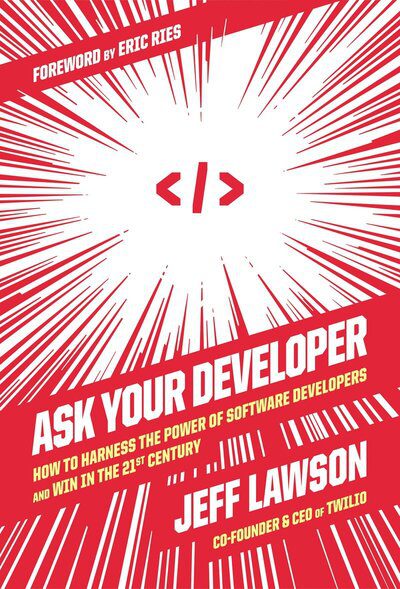In Ask Your Developer: How to Harness the Power of Software Developers and Win in the 21st Century, Twilio CEO Jeff Lawson shares strategies and tips for unleashing the full potential of software developers in any organization. Jeff Lawson founded Twilio in 2008 with the belief that empowering developers was key to unlocking innovation within nearly every kind of business.
Ask Your Developer is a framework for business leaders, product managers, technical leaders, software developers, and executives to achieve their common goal—building great digital products and experiences.
Twilio provides programmable communication tools for making and receiving phone calls, sending and receiving text messages, and performing other communication functions using its web service APIs.
Ask your developers
The companies that harness the power of software to deliver the best digital customer experiences will survive and thrive in the digital age. Build vs. Die means recruiting great developers, but more important, putting faith in those developers, turning to them not just for code but for creative problem-solving.
The Ask your developer metaphor came about when Twilio hired an advertising agency to create a billboard campaign. Jeff half-jokingly asked
“Why don’t we just say, ‘Ask your developer,’” I said. “You know, like those ads
on TV where they say, ‘Ask your doctor if this.
“Developers were the ones spreading the word about us and our product. We didn’t do a ton of marketing, and we employed only a handful of sales reps. Most of our employees at the time were engineers. If someone wanted to find out what Twilio did, the best way to do that really would be to ask a developer.”
Twilio sell a service to software developers that lets their apps communicate with voice, SMS, email, and more. We have amazing customers—Uber, WhatsApp, Lyft, Zendesk, OpenTable, Nordstrom, Nike. The twilio software hides under the covers, inside websites and mobile apps. In fact, you’ve undoubtedly used Twilio, without knowing it, if you’re a customer of any of those companies or thousands more like them.
Twilio
Twilio is embedded into thousands of apps and websites. When you text your Uber driver from inside the Uber app? That’s Twilio. When Netflix sends you a text message with a six-digit code before it lets you sign in. When you order dinner from DoorDash, the notification that your food has arrived is sent via Twilio. You probably use Twilio every day but don’t realize it.
Build vs. Die
It is not the strongest species that survive, nor the most intelligent, but the ones most responsive to change. —Charles Darwin, On the Origin of Species
From Cost Center to Profit Cente
Digital natives—the startups that know how to build software—start to win market share. In response, one of the incumbents, intent on fending off the upstart, reverses the IT-outsourcing trend and starts assembling their in-house software teams to compete. One by one, every player in the industry (the ones that intend to survive, at least) becomes a builder. It’s unavoidable. It’s mandatory.
The Company with the best software wins
Companies that adapt to the new digital landscape will serve customers better, and will survive. Those that don’t will die. It may not be overnight, but it’s inevitable. It’s as simple as that. It doesn’t matter what business you’re in. Banks. Airlines. Automakers. Insurance companies. Real estate. Retailers. Health care. Sure, you also have to deliver a great product or service at a competitive price. But in every market, the company with the best software will eventually win.
Rule of Thumb:
Anything that gives you differentiation with customers, you should build. Software that faces your customers, you should build. Anything where your customers will be saying, why doesn’t it do X, and your answer is, well, the thing we bought doesn’t do X. That’s a problem. When your customers care, you need to build. There may be cases where it also makes sense to write your back-end software. You may be in a business where you can gain a competitive edge by how well you manage your inventory. In that case, sure, go build your own supply chain software.
“This is how innovation works: experimentation is the prerequisite to innovation. The more quickly and cheaply you can run experiments, the faster you’ll eventually find something that works. ”
Naming Twilio
First, we needed a name. I’m a big believer in having a unique proper noun for the company that can be owned completely. We started making sounds with our mouths—literally just expressing syllables that sounded remotely like telephone. “Teliph.” “Telefoo.” “Telapia.” Nope, that’s a fish. We kept making sounds. It must have been hilarious to listen to, but we didn’t care. After about twenty minutes, I said: “Twili. Tweli. Twilio.” The last one had a ring to it. Amazingly, Twilio.com was available for seven dollars, so I bought it. That was that. We’d named our company.
Share Problems, Not Solutions
There’s an old story about NASA trying to develop a pen that astronauts could use in space. It was tricky to get ink to flow upside down, and pens kept failing. We spent millions of dollars trying to come up with a space pen, until someone realized how the Russians solved the problem—they used pencils.
“The problem NASA needed to solve was not “How can we make a pen that writes upside down in zero gravity?” The real problem was “How can we write in space?”
Ask Your Developer is about setting high expectations for developers—not how much code can they grind out, but how well can they use their ingenuity and creativity to solve the world’s biggest problems. They can do this only if they’re empowered and given a wide enough berth.
The most important thing is to give developers problems, not solutions.
Learning to Learn
“That process of learning to learn is one that every child goes through, starting in kindergarten. Yet once we graduate and enter the workforce, we seem to forget about all that. The process of “learning to learn” gets lost. We create rigid, unforgiving cultures that punish people who make mistakes. That approach might have worked in some bygone era – But it certainly does not work in today’s economy, where companies are locked in a Darwinian battle for survival in a world where the rules keep changing. Survival means being lean, nimble, fast, and constantly able to adapt.”
The Blameless Postmortem
“When things go wrong, it’s either a time to blame, or a time to learn. I believe each failure is an opportunity to uncover deep learnings about how the organization operates, and what could strengthen it systematically, and then take action. We, and many other software companies, do this via a ritual called the “blameless postmortem.” The purpose of the blameless postmort is to dig below the surface of some kind of bad outcome to the true root cause, and address that as an organization. ”
All the best in your quest to get better. Don’t Settle: Live with Passion.



Comments are closed.